|
工程
Process |
作業内容
How |
写真とコメント
Photos and coments |
1
|
苧倒し
Cutting down the basho tree |
10月から2月頃芭蕉を刈り取る。
The best season for cutting is between October and February. |
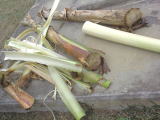 糸芭蕉は一度植えれば地下茎で増え続け、数十年は植え替える必要がないのですが、最初の3〜4年は粗い繊維しか取れないといいます。 糸芭蕉は一度植えれば地下茎で増え続け、数十年は植え替える必要がないのですが、最初の3〜4年は粗い繊維しか取れないといいます。
The root of basho for textile multiplies and ther is no need of replanting
for dozenas of years. |
| 2 |
苧剥ぎ
Separating the skins |
根元から先に向かって1枚ずつ剥ぎ、外側から、外皮、中皮、内皮、芯の4種類に分けられる。内皮が着物の生地になる。
The skins are stripped off from the base to the tip.The skins are classified
into four parts; outer ones,middle ones,inner ones and core ones. The inner
ones are used for kimono. |
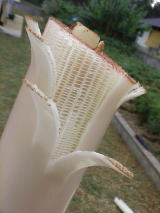 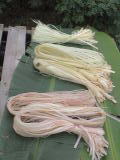 |
3
|
苧炊き
Boiling |
4種類の繊維を別々に灰汁で数時間炊く。
The skin of each class is boiled in the water with ash lye for several
hours.The skin of each class must be boiled separately from the others. |
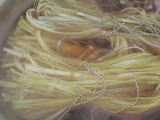 |
| 4 |
苧引き
Scraping the skin
|
炊き上がった繊維を水で洗って灰汁を落とし、竹の道具でしごく。その後乾燥し、チングいう玉状に巻いておく。
The boiled skin is cleaned in the water and scraped with a tool made of
bamboo.After that the skin is dried and wound up in the ball-like form
called"chingu″. |
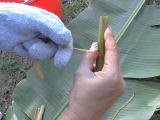 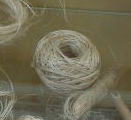 |
| 5 |
苧績み
Joining the fibers |
チングを湿らし、繊維を目的の太さに裂いて、繋いでゆく。芭蕉布では機結びで繋ぐことが多い。
The chingu ball is dipped in the water and the skin is devided into the
needed thickness.Then the ends of two fibers are tied in "hata-musubi″which is
often used for weaving. |
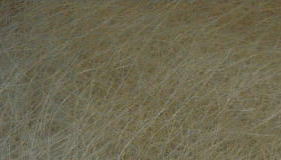 |
| 6 |
撚りかけ
Twisting the string |
経糸は糸車で撚りを掛ける。緯糸は撚りを掛けずに管に巻く。
The warp yarn is twisted with the twister wheel.The weft is wound like
the photo right. |
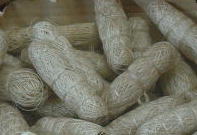 |
| 7〜 |
整経、製織、等
Warping, weaving,etc. |
目的により、工程が異なります。
The process depends on the aimed item. |
|
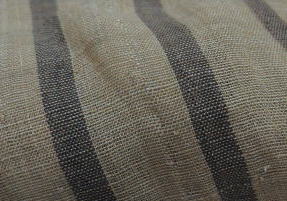
 糸芭蕉は一度植えれば地下茎で増え続け、数十年は植え替える必要がないのですが、最初の3〜4年は粗い繊維しか取れないといいます。
糸芭蕉は一度植えれば地下茎で増え続け、数十年は植え替える必要がないのですが、最初の3〜4年は粗い繊維しか取れないといいます。





